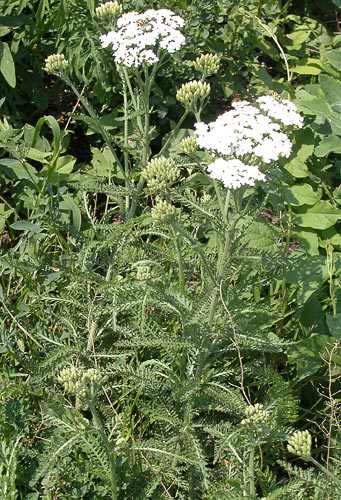Weeds
Achillea millefolium L. - Yarrow.
Systematic position.
Family Asteraceae (Compositae), genus Achillea L. Two former subspecies [A.millefolium subsp. collina (J.Beck. ex Reichenb.) Weiss and A. millefolium subsp. pannonica (Scheele) Hayek] are now considered as independent species occurring in the territory of the former USSR.Synonyms.
A. submillefolium Klok & Krytzka, p.p. incl. typoCommon Yarrow, Milfoil, or Bloodwort.
Biological group.
Perennial rhizome plant.Morphology and biology.
The root system consists of numerous roots and rhizomes. Stalks are 20-60 (120) cm tall, upright, single or few in number, simple or ramified in the upper part. Leaves are lanceolate, oblong, 3-15 (lower ones to 40) cm long, 0.5-3(5) cm wide, with dotty glands from below, bi- or tri-pinnatisect (not to the base), with numerous (15-30) primary lobes having 9-15 secondary lobules. Leaves are usually pubescent, lower ones petiolar and upper ones sedentary. Phyllotaxy alternate. Inflorescence consists of small calathidia (4 to 10 mm in diameter) located in numerous, composite cymes, unequal in height. Involucral leaflets green or brown, oblong to almost ovoid, 3-4 (6) mm long, with elevated median rib and scarious edging along margins. Five marginal flowers white or pink; their ligules are 2-4 mm long, almost rounded, indented at top. Central tubular flowers are 14-20 in number; they are bisexual, dirty-white or yellowish. Lower ovary is unilocular. Receptacle is convex to conic. Bracts on receptacle are ovoid and scarious. Fruits are flat oblong silvery-gray hemicarps, 1.5-2.3 mm long, 0.5-0.9 mm wide, with fine longitudinal grooves and lateral aliform margins. Blossoms from May until October. Bears fruit beginning in August and this is frequently simultaneous with a second blossoming. Maximum fertility produces about 25 thousand hemicarps; fresh hemicarps sprout from a depth of not more than 3-4 cm. Reproduction by seeds and cloning.Distribution.
Distributed throughout Europe; in Asia reaches the Himalayas; in Japan and China it is an introduced plant. It is introduced and settled in Northern America, Australia and New Zealand. In the territory of the former USSR it occurs almost everywhere, except for the northern areas of Siberia and the Far East; in deserts and semi-deserts of Central Asia. Isolated occurrences of this species are found in valleys of small rivers in Central Kazakhstan and in the foothills of Kopetdag.Ecology.
Yarrow does not need rich ground, but avoids excessively acidic and solonetzic soils. Resistant to trampling. The species does not require warmth and moisture, but does not thrive with over-watering. The plant is sensitive to shade, preferring open sunny places. Yarrow is found in meadows, forest edges, glades, in light woods and along coasts of reservoirs. The species is distributed across most of the entire country, being especially abundant in forest, forest-steppe, and steppe zones. It is also a widespread ruderal and segetal plant. In anthropogenic landscapes it frequently grows among crops, on fallow lands, meadows, pastures, and in refuse sites.Economic significance.
Young plants are readily eaten by cattle and give an aroma to the hay. Later the stalks become ligneous and inedible. Grows among crops of all cultures in forest, forest-steppe, and steppe zones. Control measures include: preventing the spread of Yarrow seeds from the sowing material or croplands and regularly destroying rhizomes of the Yarrow by using appropriate soil treatment types and herbicides.Reference citations:
Cherepanov S.K. 1995. Vascular plants of Russia and adjacent states (of the former USSR). St. Petersburg: Mir I semya. 991 pp. (In Russian)Chikov P.S., ed. 1976. Atlas of areas and resources of herbs of the USSR. Moscow. 340 pp. (In Russian)
Fisyunov A.V. 1984. Weeds. Moscow: Kolos. 320 pp. (In Russian)
Kott S.A. 1955. Weed plants and their control. Moscow: Selhozgiz. 2 ed. 384 pp. (In Russian)
Maltsev A.I. 1939. Atlas of main weeds of the USSR. Moscow-Leningrad: Selkhozgiz. Part 2. 88 pp. (In Russian)


